
Hi guys, this is Nikki Lead Veterinary Technician with Posh Dog Knee Braces, and today let’s discuss how many hours a day your dog should wear a knee brace. Now this also really depends on what we are treating. If we have a full CCL tear with meniscus involvement, I may suggest you use the brace more often than a patient with a partial tear.
Also, how much energy your dog has is a big factor on how many hours you really need to be using the brace. Some brace companies say wear the brace all day long, with no breaks. This can lead to a lot of problems initially, if you have not properly broken in the wearing time of your brace.
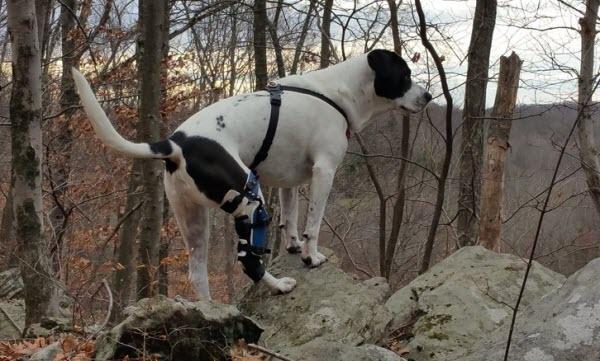
If you have a high energy dog, one that dives off of stairs and furniture, and is harder to control, you may be advised to use the brace a bit more. Now, we only suggest using braces during times that your dog is supervised. This is a medical device, and should not be worn without direct supervision. I would suggest starting out slow, just using the brace during walks and activities hours your veterinary technician will go over with you. Once your dog has been using the brace well, and you feel more confident, you can begin to increase the amount of time (hours) your dog uses the brace.
I still like to give breaks during the day, especially if there is a time they like to lay down and nap. For instance, using the brace for 2 to 3 hours in the morning, while they get the wiggles out, go potty, walk, and breakfast is perfectly fine. You may then opt to remove the brace during lunchtime, as most dogs calm down around this time. Then, you can place the brace back on in the afternoon, and remove prior to going to bed. This is just a suggested scenario, but again you do need to continue monitoring them with the brace.
We do not suggest any patient to wear the brace 8-12 hours a day, as anything that is worn that long on human or dog can cause skin irritation.
If your dog is pretty chill, relaxed, and only really active outside (such as giant breeds), then I would suggest using the brace just for activities. These can include walks, car rides, when someone comes to visit, playing with another dog, stairs, ect. If they spend most of their time laying down, it would not be comfortable to leave a brace on all day long. Let them get cozy, but we will be suggesting some Physical therapy activities to help prevent atrophy.
Put a sign outside your door, this will help discourage people from ringing the doorbell or knocking. Most dogs react to hearing a knock and doorbell, so if we can cut back on those times that will really help with preventing re-injury. Instead, put your phone number on the sign, so they can text you if someone arrives to visit.
Always feel free to speak to your service veterinary technician with any questions, that is what we are here for! Thank you, and give your dog a big hug for us!
You can contact us via our contact page or visit our Facebook page for more information.
Let Your Dog Recover With Our Custom Dog Knee Brace!
We’ve Helped Dogs All Around The World, Now We Want To Help Yours…
The Posh Dog Knee Brace is a 100% custom Dog knee brace, hand made only for your Dog. We make our custom brace with no casting. Our state-of-the-art brace for Dogs is very durable, waterproof, sand proof, and easily adjustable by customers. Our Veterinary Technicians provide personal live video supervision of measuring, and fitting of your Dog ACL brace in the comfort of your own home.
Dog knee braces, also known as stifle braces, are orthopedic devices designed to provide support, stability. These braces are commonly used in the management of various knee-related issues, including ligament injuries, osteoarthritis, or after surgical procedures. The science behind dog knee braces involves biomechanics, support, and the promotion of healing. Here are some key aspects:
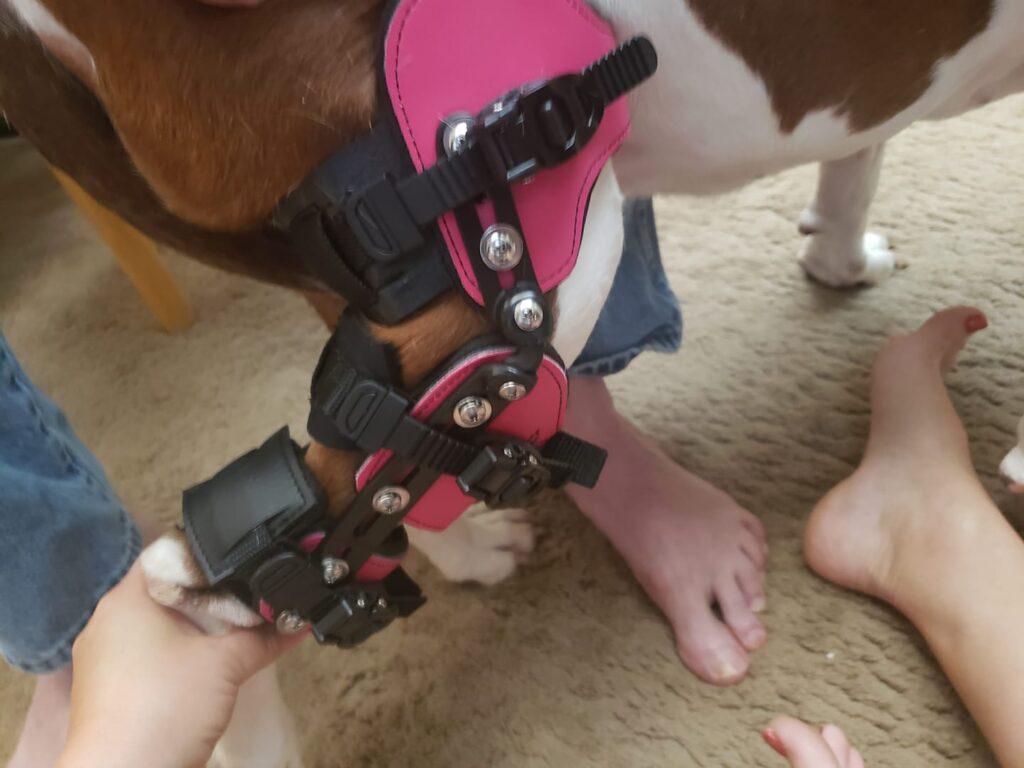
While knee braces can be beneficial, they are not a one-size-fits-all solution, and their effectiveness may vary depending on the nature and severity of the knee issue. Always consult with a veterinarian for a proper diagnosis and guidance on the use of knee braces for your dog’s specific condition. Also check the materials, and make sure the brace is custom.
If you are interested in a Posh Dog Knee Brace you can order online or contact us with more information, visit our Facebook Page to see what our customers have to say.
Dogs can be prone to injuries related to various physical activities. Understanding the types of injuries associated with specific activities can help dog owners take preventive measures and seek appropriate veterinary care when needed. Here are common activity-related dog injuries:
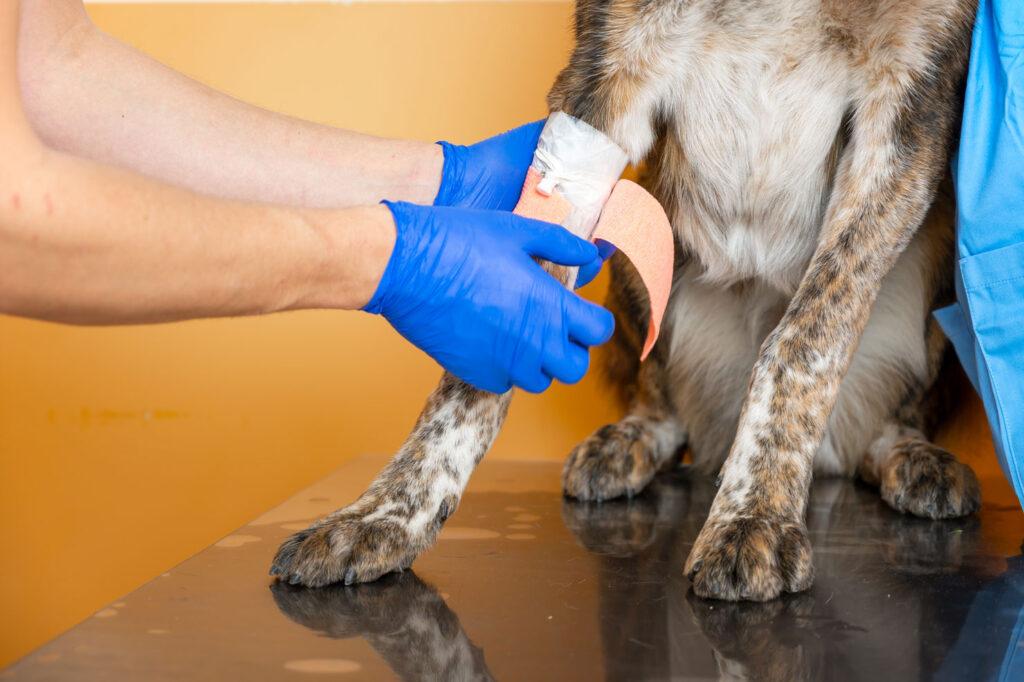
Preventing activity-related injuries involves being mindful of your dog’s limitations, ensuring they are adequately conditioned for the activity, and providing proper warm-up and cool-down periods. Regular veterinary check-ups can help detect and address any underlying health issues that might predispose a dog to injuries during physical activities. If an injury occurs, prompt veterinary attention is essential to ensure proper diagnosis and treatment.
For more information about related injuries or if you would like information about our brace contact us via our contact form or visit our Facebook page.
Hello! This is Nikki, Lead Veterinary Technician with Posh Dog Knee Braces. Today let’s go over how to break-in a new Posh Custom Dog Brace. First, we want to take things nice and slow. You wouldn’t take a brand new pair of boots to Disneyland resort for 10 miles of walking each day I hope. Neither should we put a custom brace on a dog for 8-12 hours without first working into that time. Just like in people, a dog’s skin needs some time to get adjusted to wearing something.
Over the next few weeks, as we gradually increase the times we have them in the brace, the skin will start to thicken and get stronger. Just like our feet do with a new pair of shoes. After a few short weeks, they should be able to tolerate wearing the brace longer and longer.

In the first 1-2 weeks, we suggest only using the brace during short leashed walks. This is to get your dog used to walking in the brace, to prevent soreness, and to get their skin used to having something touching. It can take a patient sometimes up to 3-4 weeks for the soreness in the muscle to get better, just like if we did physical therapy.
You wouldn’t want to run a 10K marathon with no practice or training, right? Even if your dog was walking 4+ miles each day before the injury, we now have atrophy and muscle loss (yes even if its only been a few weeks). Starting out with nice slow walks, and building up the times slowly, will really help prevent soreness and rubbing issues.
We typically don’t see rubbing sores with Posh, because we are so clear on our direction to our clients. Wearing the brace gradually more and more each week, really helps them adapt to having something touching their sensitive areas. The upper groin and ankle area seem to be the most common areas we see any irritation, and usually if the brace was worn for too long too fast. Doing 10-15 minutes twice daily for 2 weeks, then adding 15 minutes weekly to their walk schedule will really help.
We have this break-in schedule completely broken down for our clients in the handouts we send after the brace has been fit properly with a technician. A custom brace should never be worn right off without some sort of consultation, to ensure proper fit and make sure your dog is using the brace properly. Any company that does not do this is a red flag in my book.
Let me know if you have any questions about our break-in schedule! Please contact us via our contact page or visit our Facebook Page.
Nikki, Posh Lead Veterinary Technician
Reiki is a form of alternative therapy that originated in Japan and is based on the concept of channeling healing energy through the practitioner’s hands. While scientific evidence supporting the effectiveness of Reiki is limited, some dog owners and practitioners believe that it can provide various benefits for dogs. It’s essential to note that Reiki should not replace conventional veterinary care but can be used as a complementary approach.
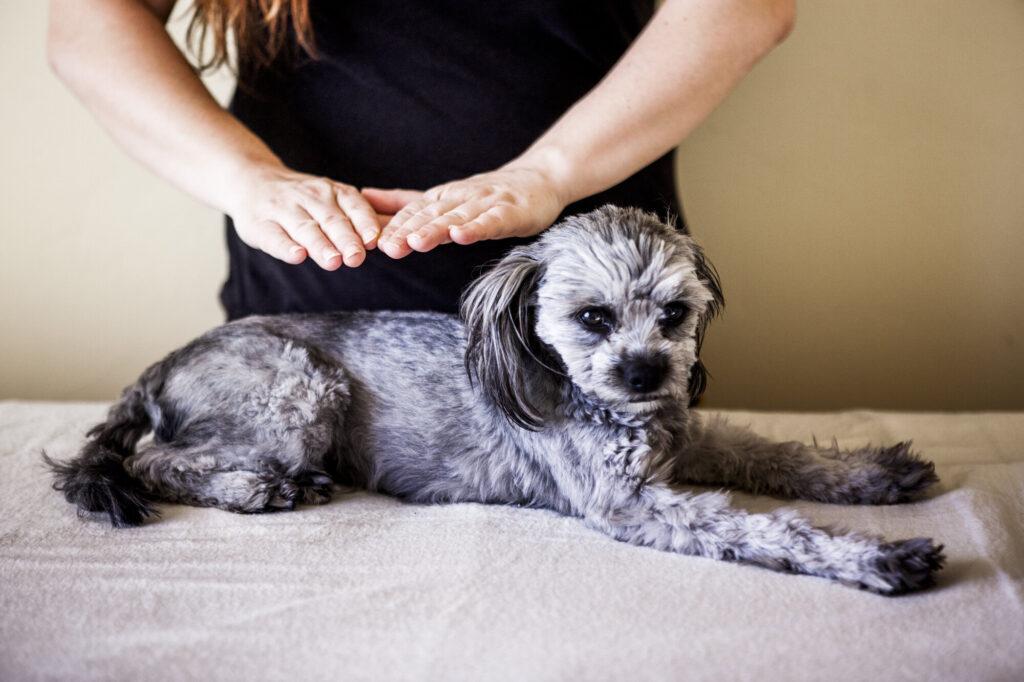
While some dog owners report positive experiences with Reiki, it’s important to approach it with an open mind and consult with a veterinarian before incorporating it into your dog’s care plan. Always prioritize conventional veterinary care for diagnosing and treating medical conditions.
For more information on how to help your dog recover with their injuries or if you are interested in a Posh Dog Knee Brace you can contact us via our contact page or visit us on Facebook.
Knee injuries are relatively common in dogs and can lead to varying degrees of pain, lameness, and mobility issues. One of the most prevalent knee injuries in dogs is a torn cranial cruciate ligament (CCL), which is analogous to the anterior cruciate ligament (ACL) in humans. The CCL helps stabilize the knee joint and prevent excessive movement between the femur and tibia bones.
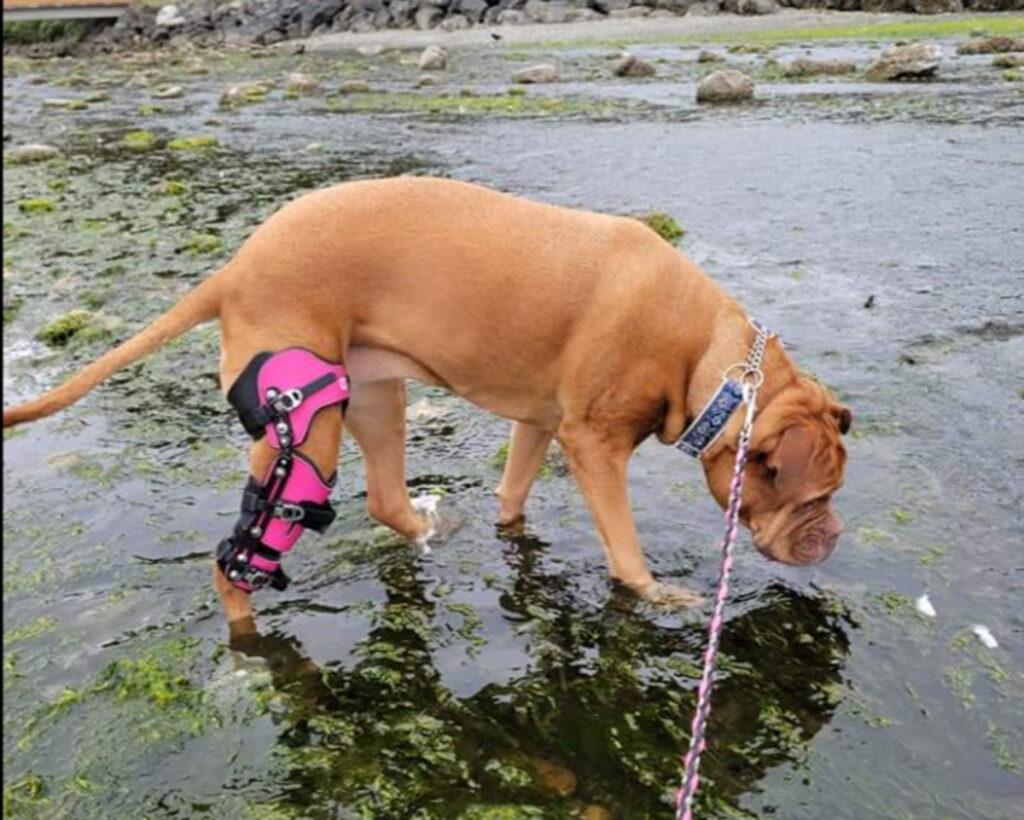
If you suspect your dog has a knee injury or is experiencing any of the above symptoms, it’s essential to seek veterinary attention promptly. Your veterinarian will conduct a thorough physical examination, possibly including X-rays or other imaging tests, to diagnose the specific knee injury and develop an appropriate treatment plan.
The choice of treatment will depend on the severity of the injury, the dog’s age and overall health, and the veterinarian’s recommendation. Early diagnosis and appropriate treatment are crucial for improving the dog’s comfort and mobility and preventing further joint damage or complications.
If you are interested in purchasing a Posh Dog Knee Brace you can order from our shopping page or if you have questions about our brace you can reach out to us via our contact form or visit our Facebook page for more information.
Today I would like to talk about recommended activity levels with a brace or CCL tear. It is still important to remember that this is not a race. Recovery from a CCL takes time, which is why we use a gradual increase in activities.
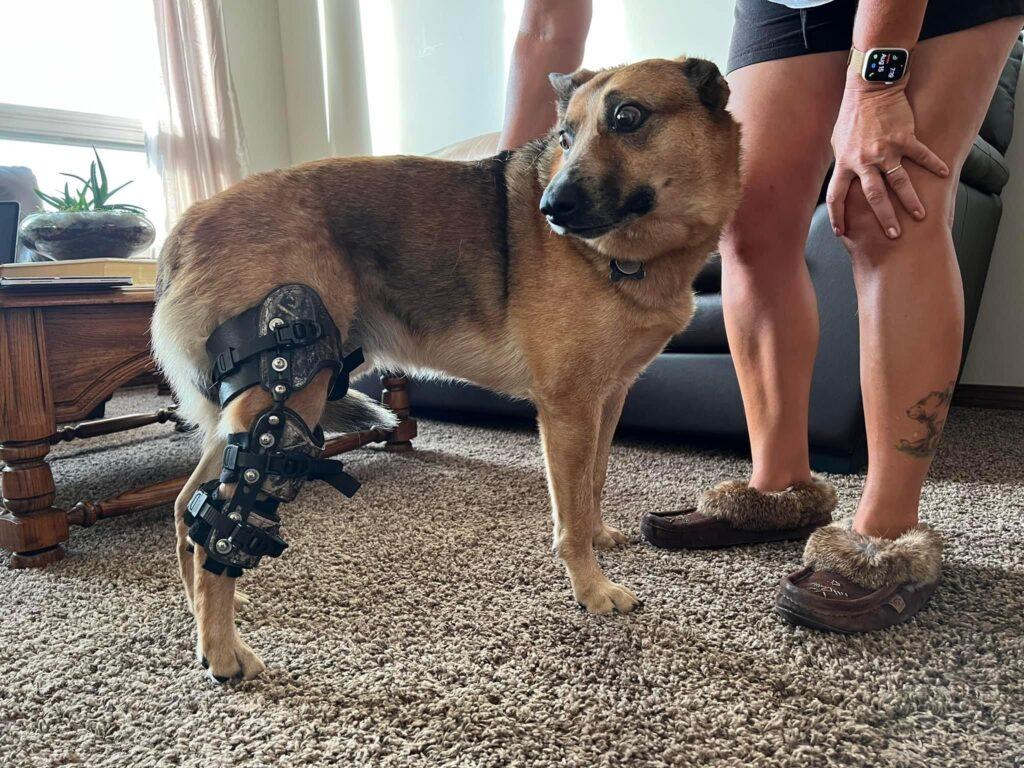
Initially, we start with walks and light physical therapy and massage. Gradually, we can increase activities, such as adding hills or inclines to the walk, sit stands, more muscle building activities.
It is not recommended to let your dog run off leash while in recovery. This can lead to injury of the other leg potentially. Braced walks are meant to be nice and slow, not a jog. The goal is to have your dog placing full weight down on his leg. If you walk or run too fast, they will skip and not place full weight on the leg.
We will get to a point where your pup can play off leash, but ask first, and take things slow. Feel free to email or send in a contact request with any questions, we are happy to help!
Give Your Dog a Big Hug From Us!
Nikki, Posh Lead Veterinary Technician
Looking for more information about our Posh Dog Knee Brace contact us via our contact form or visit our Facebook Page.
Finding relief for arthritis in dogs involves a combination of veterinary care, lifestyle adjustments, and supportive therapies. Arthritis is a degenerative joint disease that causes pain and inflammation in the joints, and it is common in senior dogs and large breeds. Here are some ways to help relieve arthritis in dogs:
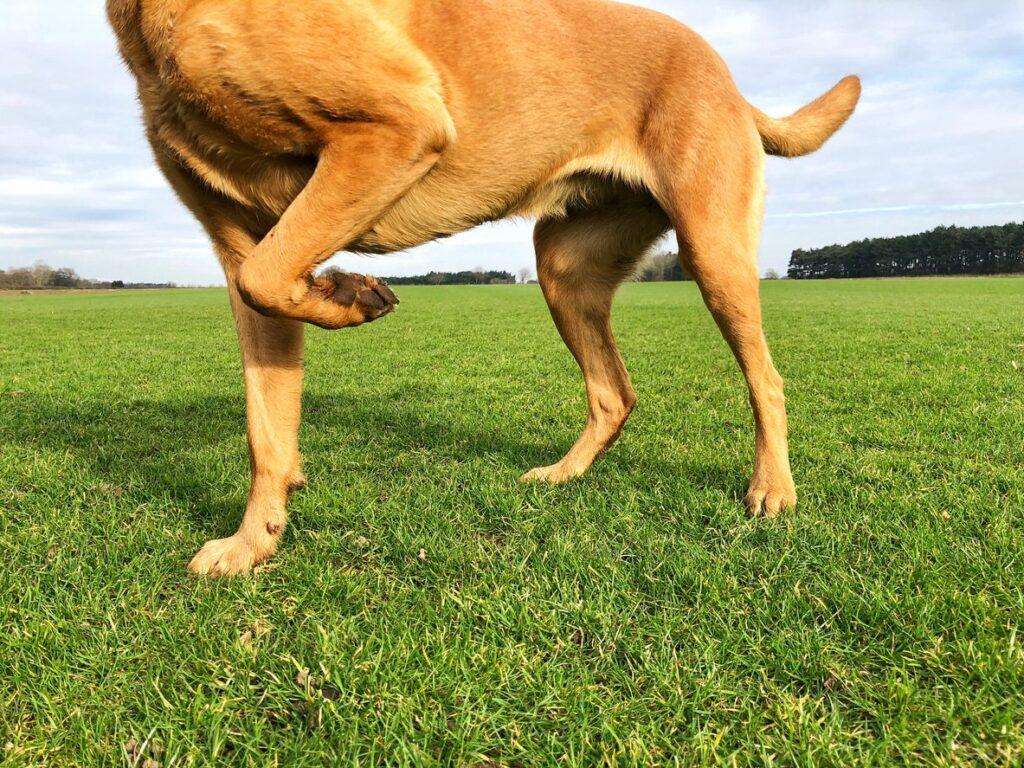
Remember that arthritis is a chronic condition, and while these measures can provide relief and improve your dog’s comfort, there is no cure for arthritis. Regular veterinary check-ups and ongoing management are essential to support your dog’s well-being and manage the progression of the disease. If you would like more information about our Posh Dog Knee Brace contact us via are contact page or visit our Facebook page.
Hey guys, this is Nikki the lead veterinary technician with Posh Dog Knee Braces. Today, let’s talk about how being overweight can affect our joints. As you know, the more weight we have, the more pressure we put on our joints and internal organs. This can put the body in a state of inflammation, as well as predispose us to many ailments and orthopedic issues. We are making our joints work much harder, which starts a vicious cycle on inactivity. The more the joints are sore, the less your dog will want to walk, which can cause the muscles to atrophy. Pretty soon we have a pup with less muscle, and much more prone to physical injuries like CCL tearing.
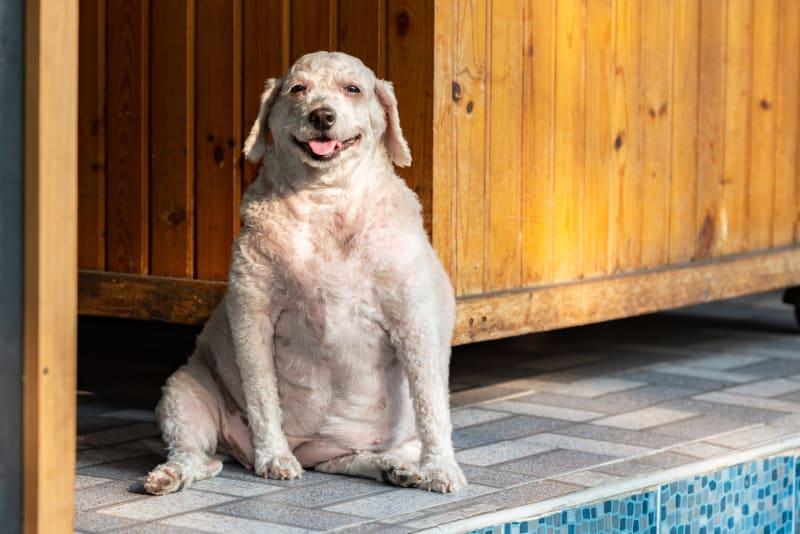
Not only does weight gain affect the organs and joints, but it also can shorten life expectancy by quite a bit. Unfortunately, this is not going to be a quick fix situation. It is much easier to get the weight off a younger dog than one that is aging. Prevention is much easier than treatment, especially if your dog is spayed or neutered, which can increase the chances of becoming overweight.
If your dog is in the top weight percentile, and does not yet have any limping issues, it’s time to get serious about weight loss. Things you can do first is check everything that you are feeding your dog every day. I want a list of each and every treat, kibble, and snack. Small things like swapping daily treats for a carrot or sweet potato stick, ect can help, as well as increasing exercise. If you have a dog that does not like to exercise, starting slow is key. Maybe 15 minutes a few times daily will really help. It is important not to skip exercise. Walking and swimming is great.
Second, changing diet is next. If you are feeding a diet that has a lot of carbohydrates, and less protein, it may be time to switch. I like diets with a good quality protein source, not by products. Make sure you are not feeding grocery store foods, unless you absolutely have to. There are many good quality foods out there. If you are already feeding a good quality food, make sure you are not feeding too much.
If you are not sure what to be feeding your dog to help, please consult with your veterinarian, maybe schedule a time to go over the nutritional needs of your dog with your Dr. or a veterinary technician. They may have a specific diet they recommend.
If you have an overweight dog that already has a limp or headed for a CCL tear, but not there yet, then I would strongly suggest finding a physical therapy clinic, one with hydrotherapy. This will help strengthen the leg, and loose weight.
Please call or email with any questions! www.poshdogkneebrace.com or visit our Facebook Page.
Hey guys, this is Nikki Lead Veterinary Technician with Posh Dog knee Braces. This is one of my most common questions asked will my dog need a knee brace forever for a CCL/ACL tear?, and I would like to dive deeper to answer this question, as there is more to the answer than simply No.

First off, the majority of my patients will use the posh dog knee brace for about 9 months, sometimes up to 12 months if they are a larger breed or have a minor meniscal tear. We know that scar tissue is mature by the 9-12 month point, and at the juvenile stage around month 2-3. If someone tells you that your dog will be permanently using the knee brace, they are simply misinformed. There are actually quite a few studies in both humans and animals, proving the timeline of scar tissue formation.
In surgical sites, or areas of soft tissue, scar tissue can form much faster, forming a thickened scar within weeks. This is different from the fibrous tissue that forms in a joint, and gives us regained stability. Let me ask you this, have you ever sprained your ankle or injured a joint?
Did you use a splint or a knee brace to help that joint recover? I know I have. Depending on the joint, and amount of muscle you were able to keep with physical therapy, also plays a key role in the longevity of using the brace. We do not want to keep the brace on forever, however, in some severe arthritis cases, or luxating patella issues, bracing longer term as needed may be necessary.
How do you know when it is time to take your dog out of the knee brace? Time will tell on this one. Most dogs are ready to go, and fully weight bearing by 9-12 months. However, if you were unable to complete the physical therapy recommendations during the recovery times, your dog may need longer in the brace while they acclimate slowly to walking without the brace on.
This needs to be a slow weaning process, so as not to cause a re-injury. Take your dog for a nice leash walk, without the brace. If you dog does great, and has no sign of a limp or gait that is off, then you can continue to leash walk without the brace for a bit longer until you feel comfortable letting your dog resume activites.
Some dogs may need a little longer than 12 months, such as patients with meniscal tears or arthritis, or if there was a re-injury during the healing process. This is still not forever, I would take things month by month until you are successful at walks without the brace on. Our service technicians are happy to answer any questions you may have about this process, and there is really not a wrong answer. If you feel more comfortable having your dog wear the brace longer, and your dog is doing great, that’s ok!
I would suggest our Posh led support group on Facebook, where you can talk with thousands of other clients who have all used the posh brace to recover. This is a great place to learn more about what to expect, and get great advice from both our technicians and previous customers.
To sum everything up, we do need to make sure to use the brace as directed for at least 9 months, but that is usually adequate for the majority of our clients. Please check out our website, poshdogkneebrace.com, for further tips and information that may also be very helpful, you can also reach out to our facebook page as well for information.
Today we will go over some common asked questions about custom braces for dogs.
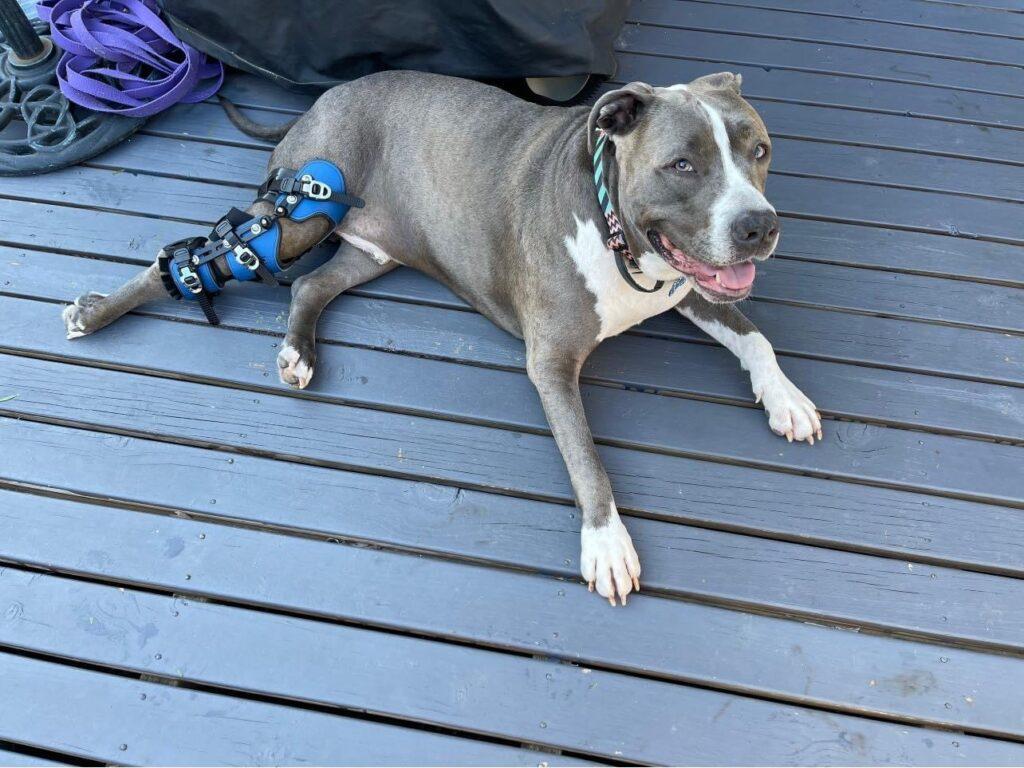
Why does our brace cost more than the over the counter options for $400-$500?
This is a good question! First off, most custom orthotics will be in the $900-$1200 range, as there is much more involved in the production than the over the counter options. For instance, with our brace each client gets 4+ hours of customer service with our veterinary technicians, both guiding them in measurements, fitting calls, rehab assistance, and supplement/diet help. There is also a lot more production time needed for custom products, and we do not start until we have the measurements from the patient. Over the counter braces are a “one brace fits all” product, so they have sized like small, medium, and large.
They do not take into account patients that are more bow legged like our staffies, or patients that need the top shell brought down a bit more to accommodate shorter legs. Plus, we do have a warranty on the parts of our brace, where a non-custom product is not only non refundable, but there is no warranty. The buyer essentially takes on all of the risk. I have many patients that have purchased a non-custom brace first, only to find it did not fit well, and were stuck. Then, they went with our Posh Dog knee Brace, and loved the custom fit, non sliding option.
Does a custom product have straps that go over the back?
No, custom braces will not have straps or stirrups that hold them in place. This is because we are a direct fit to the patient. Non-custom products are not made for your dog’s leg, so they must be held up by straps and stirrups. Our brace utilizes a hock wrap, that goes around the ankle, to help keep things from slipping down. This, and our unique strapping system, make it so our brace is much more simple to use.
Do custom dog braces need to be casted? My vet told me only to use casted braces
No, at Posh Dog Knee Braces we use a proprietary online program, that allows us to make a digital model of your dog’s leg, using specific measurements. This is why we have a veterinary technician watching and helping each patient take the measurements that we need. Our process is much faster and easier than casting, and production typically only 3-4 business days, with express shipping.
What is the materials of a custom vs. non custom brace? Are they made of the same stuff?
Again, great question. A non custom, over the counter brace is made of cheaper materials, such as neoprene and sometimes a cheaper metal hinge. This means they are not going to last you long, and will not be waterproof. Our Posh Brace is made of only the best orthotic materials, similar to pediatric orthotics, so that they are both durable, comfortable, and easily cleaned. Our dog knee brace can also be used in hydrotherapy.
For more information you can reach us via our contact form or visit our Facebook Page.
Hey guys, Nikki with posh dog knee braces here. So, first of all I can’t stress enough the need to do some form of physical therapy. We send every patient home with a 12 week recovery calendar and exercises, however, we need you to keep those up for the full 9 months. Whether you find a holistic or physical therapy clinic to help you with water treadmill or PT, you need to keep you dog active in some way.
Lack of activity will cause a joint to “lock up” after the scar tissue has formed, meaning there is not going to be the same amount of range of motion there. There also can be loss of muscle. The brace alone is not enough to build muscle, you will need to keep walking your dog, and doing some form of exercise program. This is needed whether you do surgery, Conservative management, or bracing. Doing nothing will result in loss of muscle, loss of range of motion, and most likely arthritis and pain down the road.
We have a lovely list of holistic veterinarians and rehab clinics around the US and in Canada, so reach out if you are struggling to find a clinic. The clinics on our list are partners with posh, and know how to treat our patients, as well as measure and fit the brace if needed. We do have some things we can have you do from home as well, if PT is just not in the budget. I am happy with walks, simple exercises, and passive range of motion.
What is PROM? This is you gently bending and flexing the knee, as well as the hip. I have videos we send to you on how to do this stretching, but this is key to keep flexibility in the joint, and not end up with lack of movement there.
Please let us know if you have any questions, poshdogkneebrace.com or visit our Facebook Page. Thanks!
How to exercise your dog using our brace. Hey guys, this is Nikki Lead Veterinary Technician with Posh Dog Knee Braces,we are going to talk about excerises for your dog. Today let’s talk about how to keep your injured dog active using our brace and how to exercise with it. As you know, after surgery there is several weeks that you would need to have your dog kenneled with no exercising, leading to atrophy of the muscles and overcompensating on the other joints. With our brace, patients are able to fully weight bear and start walks right away, decreasing the chances for overcompensating.
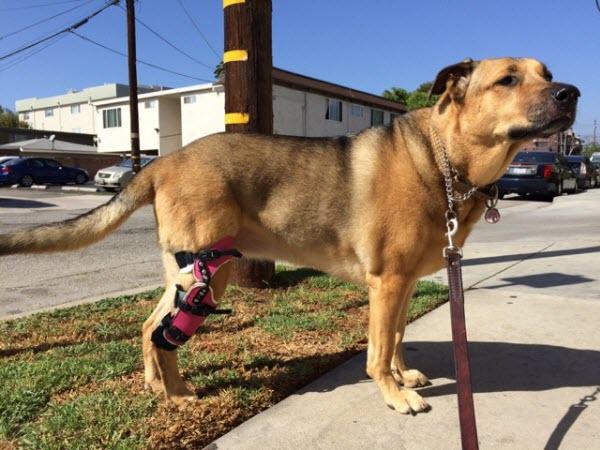
Just like us, we want to start out slowly, so as not to over-use those muscles that have been unused since the onset of the injury. I suggest starting out with no more than 2 fifteen minute walks per day for excerising, and gradually increasing the amount of walking each week by about 10-15 minutes, as the patient starts getting stronger. Each patient is different in the amount you are able to start walks, and there may be some initial soreness for the first 2 weeks. This will go away as we start gaining muscle back.
Once our patients are able to walk comfortably for at least 20-30 minutes, after a few weeks, we can start encouraging things like swimming, hills, beach walking, and curbwork for exercises. Swimming can be at a physical therapy clinic, swimming pool, or a beach. Just no jumping into the water and climbing yet. Short hills and small hikes are great tools to keep those muscles working out.
We do offer a 12 week physical therapy program with each of our patients, which includes stretches and different exercises, such as figure 8’s, curb work, walks, hydrotherapy, ect. It is important to keep up with passive range of motion as you work into more activities, to prevent soreness and stiffness in the muscles and joints. As we are developing scar tissue, we want to keep up with gentle movements in the knee. This is important to help the development of healthy scar tissues.
After a few months, gentle trots and increased activities will be ok, as long as the patient is supervised. As we start to approach the 6-9 month mark, there should be more and more stability to the joint, even without the brace on. As the knee begins to stabilize, we can do more and more activities. We still need to refrain from excessive running, jumping, twisting, or playing fetch until things are fully recovered. This is usually after about 12 months. Always ask our technicians if you have any questions on activities planned.
For more information about how to exercise your dog you can contact through our contact form or visit or Facebook Page.
Any number of ailments might result in a dog’s hind-legs losing strength. The following hints will help your veterinarian identify the problem’s root cause.
Regardless of the source, a dog’s weakness normally manifests itself first in the hind limbs. This seems obvious given how much work the dog’s hind-legs perform. They are in charge of pushing the body upward from a seated or lying position as well as driving the body forward when moving. You will be made aware of a weakness-related issue if you experience difficulty with these routine daily tasks.
What does a weak set of back legs on your dog look like? Hind-limb weakness is indicated by a variety of behaviors, including slow rising, sinking on the back limbs, dragging the tops of the toes, swaying of the hind end, occasionally crossing of the limbs, intolerance to physical exertion, slipping, sliding, and collapse of the hind end. The ability to stand on its hind-legs may also suddenly disappear in your dog.
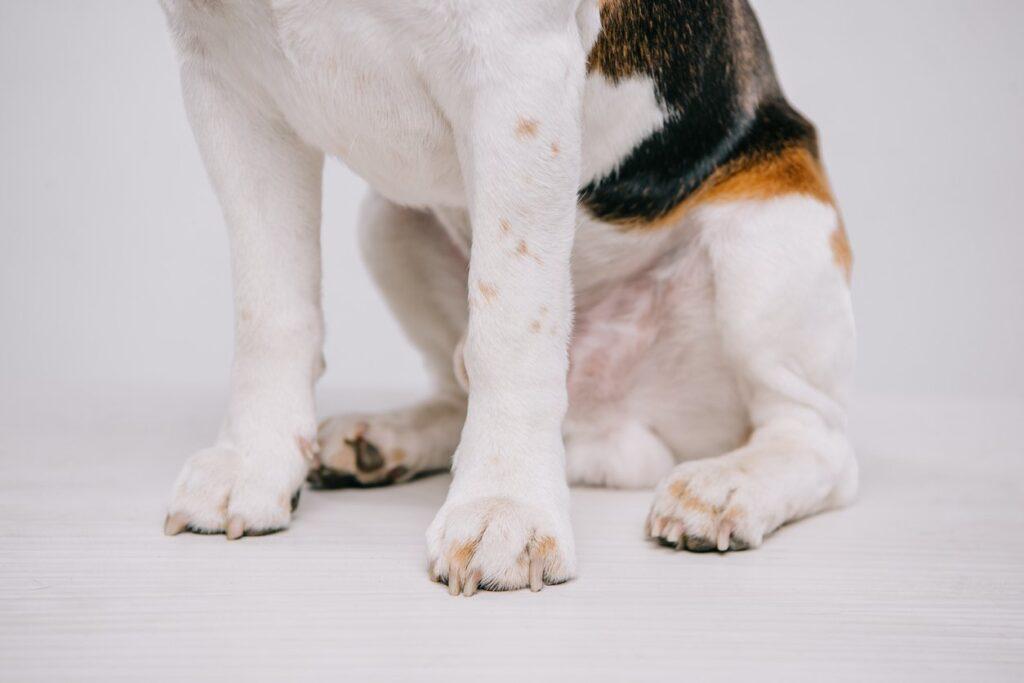
If your dog exhibits any of these symptoms, you should pay attention to a few details that can aid your vet in identifying the problem:
Some problems are more likely than others depending on your dog’s age and size. This is applied to the diagnostic procedure as well.
The four primary categories of causes of hind-leg weakness are orthopedic, neurologic, metabolic, and cardiac.
Chronic joint inflammation/pain is the primary orthopedic cause of canine hind-leg paralysis (osteoarthritis, degenerative joint disease). Although arthritis is obviously painful, it is frequently accompanied by compensatory pains, which are muscle aches and pains. The dog finds it difficult to stand up and move as a result. He might become more sedentary as a result, which would worsen the condition by causing him to lose muscle mass and fitness.
Due to the wear and tear on the joints over time, arthritis most frequently affects older dogs; overweight dogs endure an additional burden because of the increased tension those extra pounds place on the joints. Hip arthritis may appear in puppies of dogs with hip dysplasia, which results in improperly shaped hip joints. These arthritic disorders typically present with a delayed, sneaky onset of hind-leg weakening. It won’t appear to have occurred overnight.
Immune-mediated arthritis and Lyme arthritis are two acute types of arthritis that can cause a dog’s hind end to suddenly weaken. In addition to fractures and intervertebral disc disease (IVDD), overweight dogs frequently suffer from bilateral anterior cruciate ligament (ACL) tears, which are additional orthopedic reasons of hind-leg paralysis. Your veterinarian will be able to identify these diseases and recommend the proper treatment with the use of blood tests and x-rays.
IVDD: When an unhealthy disc (or discs) puts strain on the spinal cord and causes neurologic weakness, IVDD transitions from an orthopedic problem to a neurologic one. The majority of these instances are treatable medically, but surgery is necessary if paralysis develops or medical treatment is ineffective.
Spinal tumors: Similar symptoms are brought on by neurologic disorders such as spinal tumors. For a diagnosis, sophisticated imaging techniques like computed tomography (CT) or magnetic resonance imaging (MRI), as well as occasionally cerebrospinal fluid examination, are needed.
Diskospondylitis: An infection of the intervertebral disc and the ends of the surrounding vertebrae is known as diskospondylitis. It can be challenging to diagnose, produces hind-limb paralysis regularly, and is excruciatingly painful. Long-term antibiotic use is the course of treatment (six to 12 months). Your dog may need more x-rays and/or more sophisticated testing, such as CT or MRI, to make a certain diagnosis because this ailment can be challenging to diagnose in its early stages. These canines can fully recover if they are diagnosed and treated appropriately.
Lumbosacral stenosis: Cauda equina syndrome, or lumbrosacral stenosis, is a degenerative disorder that affects only the lumbosacral joint and is related to IVDD. This joint joins the last vertebra to the pelvic region. It differs from the other intervertebral joints in that the spinal cord sends all of the peripheral nerves that travel to the hind end to this joint. In addition to being extremely painful, this type of disease typically results in neurologic impairments and weak hind limbs.
Degenerative myelopathy: Weakness in the hind-legs is a symptom of degenerative myelopathy (DM), a slow but progressive deterioration of the spinal cord. Although it affects various breeds, the German Shepherd Dog serves as the disease’s mascot. Typically, older and middle-aged canines are affected. There is just supportive care available as a treatment for DM right now.
Myasthenia gravis: An autoimmune neuromuscular condition called myasthenia gravis (MG) causes muscle weakness that worsens with exertion. It may begin with weakness in the back limbs but quickly progresses to total body weakness and collapse.
Here’s a situation that is typical of Myasthenia gravis: Your dog wakes up after a nap and acts normally. As soon as you start walking, he begins to sink, slip, and stumble until he is unable to stand or walk. He can resume short-term function after a period of rest that enables the replacement of damaged neuromuscular transmitters. A blood test is required for diagnosis. Long-term therapy is required (six months or longer). Some canines will have remission and resume their regular lives. Others will require care and support throughout their lives.
Exercise-induced collapse: Labrador Retrievers and a few other breeds are susceptible to the genetic illness known as exercise-induced collapse (EIC). It usually manifests itself between the ages of 6 months and 2 years. It takes place following several minutes of intense exercise. The dog quickly starts to weaken and lose coordination in his hind limbs, eventually collapsing. For this, there is no cure. Avoiding vigorous exercise is one method of prevention. It is crucial that you get your puppy from a breeder who has tested the parents for this gene for the aforementioned reasons. Have your adoptive dog’s EIC gene checked if he exhibits these symptoms.
Idiopathic vestibular syndrome: In elderly dogs, idiopathic vestibular dysfunction is a frequent cause of weakness in the rear limbs and lack of coordination. It appears abruptly and may give you the impression that your dog is having a stroke. This disorder’s origin is uncertain. It typically comes with a head tilt and balance problems. With supportive care, the majority of dogs will recover in time.
Numerous illnesses transmitted by ticks can result in generalized neuromuscular weakness, which may first show in the rear limbs. If you notice ticks on your dog, let your vet know.
Hypoglycemia (low blood sugar), anemia (few red blood cells), and hypokalemia (low potassium) are a few examples of metabolic conditions that might weaken the hind-legs. Blood testing can quickly diagnose this. For these problems to be solved, identifying their underlying causes, which necessitates more diagnostic testing, is crucial.
Weakness can result from endocrine conditions such as insufficient thyroid hormone (hypothyroidism) and underactive adrenal glands (Addison’s disease). Blood tests are used to diagnose both conditions, and there is no cure.
Hepatic encephalopathy, a metabolic disorder that causes sporadic weakness and confusion and is most noticeable after eating, can be brought on by certain liver disorders.
All of the body’s tissues must receive sufficient blood flow and oxygen, which depends on healthy heart function. Weakness happens when heart function is compromised, regardless of the underlying cause. Again, for the reasons already mentioned, weakness in dogs typically manifests itself in the hind-legs first.
Heart illnesses that affect dogs include heartworm disease, congestive heart failure, heart muscle disease (cardiomyopathy), cardiac arrhythmias, cardiac or pericardial tumors, and fluid in the sac surrounding the heart (pericardial effusion).
Your veterinarian will discover a cardiac explanation for the hind-leg weakness you’ve noticed during your dog’s physical examination, and treatment and diagnosis will proceed from there.
As you can see, there are many different possible reasons why dogs’ hind limbs get weak. Because of this, it’s crucial to have your dog inspected if you notice this problem; never just brush it off as a “old dog” problem. Many of the underlying causes can be ruled out by your veterinarian, who can then hopefully provide a conclusive diagnosis. Even if your dog is quite old, diagnosing and treating some of these disorders can completely transform his life!
There is no cure for some chronic illnesses, such as osteoarthritis. However, there is a lot you can do to enhance and preserve your dog’s quality of life for a very, very long period. Your sensitive loving care and dedication to supportive measures are the first step.
Support for Mobility Issues Caused by Arthritis
If you are interested in more information about our Posh Dog Knee Brace you can contact us on our form or if you would like to purchase our brace you can click here, you can also join our Facebook Group page to hear how other dog parents help their dog with their pain management and therapies.
Age-related osteoarthritis affects many older dogs, as well as some larger breeds who are genetically predisposed to it. Dogs that have arthritis have changes in their affected joints, which can be excruciatingly unpleasant for your pet.
Though it can affect any joint, arthritis most frequently affects the shoulders, hips, elbows, and knees. In addition to localized damage, genetics, and disease, it can also be brought on by continual wear and tear.
If your dog exhibits any of the following 7 symptoms, schedule an appointment with your veterinarian to develop a care plan.
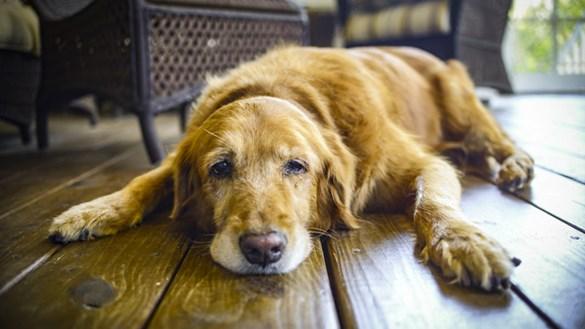
You could notice that your dog is hesitant to perform tasks that they previously completed without issue.
Maybe you’re pet used to dash into your car as soon as the doors opened, but now they seem unconcerned. You could observe that your dog has trouble ascending or descending the steps. Has your pet lost interest in playing and running around like it once did? Maybe you take walks slowly?
If your pet exhibits these changes, arthritis may be to blame. These formerly simple actions probably hurt now that your joints are inflamed.
You might notice your pet limping or favoring one or more legs over the others, depending on which joints are damaged. Your pet may even become lame in one or both rear legs if the spine is harmed.
Upon getting up or down, your dog could appear to be in discomfort or stiffness, but once they have walked a little and “warmed up,” it seems to go away.
Joint inflammation can make the affected parts feely to the touch.
If your dog appears to be rejecting your affection or howls in pain when you pet them, you may have found the source of the issue.
Has your once-adorable dog started acting more and more like an elderly man?
If moving caused you chronic discomfort, you probably would have a shorter fuse as well. That also applies to your dog. When you try to touch them, they could bite or snap, especially if you are handling them in a way that makes the discomfort worse.
Dogs with discomfort frequently don’t want to be bothered. Your pet might spend more time in the house’s quiet corners or quit pursuing you around. It’s possible that their schedule will change and they won’t be available for your usual walk or play session.
An arthritic pet will frequently focus their attention on hurting joints. They may frequently lick or chew on one or more locations, even to the point of causing hair loss and inflamed skin.
Pain wears them out!
Pets won’t want to walk as far or play as much if it is difficult for them to move around. They might spend more time relaxing or sleeping instead.
Dogs with arthritis frequently experience muscular atrophy from inactivity.
Some muscles will gradually atrophy as a result of less use. You might notice that one or more of your legs appear thinner than the others if you have arthritis in those legs.
Please schedule an appointment with your veterinarian as soon as you can if you see any of these symptoms in your pet. Even though arthritis cannot be cured, developing a treatment plan in its early stages can help your dog live a better life and make the condition more tolerable.
If you would like more information on your dog’s arthritis please contact us on our form, or you can visit our Facebook Group to see how others have helped their dogs. If you are interrested in purchasing a brace for your dog you can visit our shopping page.